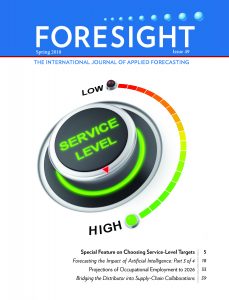Editor-in-Chief Len Tashman's Preview of Foresight
 The Spring 2018 issue of Foresight—the 49th since our beginning in 2005—opens with a feature section on Supply Chain forecasting. More specifically, it addresses the very critical matter of how a company should determine its service-level targets, or the probability that no shortages occur between the time you order more stock of the item and when it arrives on the shelf. The target set by the company converts the forecasts and forecast error magnitudes into required safety stocks for inventory management.
The Spring 2018 issue of Foresight—the 49th since our beginning in 2005—opens with a feature section on Supply Chain forecasting. More specifically, it addresses the very critical matter of how a company should determine its service-level targets, or the probability that no shortages occur between the time you order more stock of the item and when it arrives on the shelf. The target set by the company converts the forecasts and forecast error magnitudes into required safety stocks for inventory management.
The two articles in this section—Tom Willemain’s Choosing and Achieving a Target Service Level and Shaun Snapp’s How Should a Company Set Service Levels? Perception vs. Reality—show that problems in setting proper targets lie in (a) the inherent complexity of the challenge; (b) unrealistic modeling assumptions; (c) difficulties in implementing software applications that model the relationships between service levels and inventory costs; and, perhaps most tellingly, (d) the reliance in many companies on misperceptions about service-level goals and misalignment across functional areas on what the targets should be.
In our Fall 2017 issue, we began a four-part series by Spyros Makridakis on Forecasting the Impact of Artificial Intelligence. The major objective of the article in its entirety is a consideration of how AI will affect businesses and what companies can do to exploit the opportunities AI presents while avoiding the dangers by accurately predicting the impacts and planning ahead for them. In Part 2, the previous installment, Spyros examined four “scenarios of possibility” about the benefits and threats of the AI Revolution as outlined by what he designated as AI Optimists, Pessimists, Pragmatists, and Doubters.
Now, in Part 3, he analyzes The Potential Effects of AI on Businesses, Manufacturing, and Commerce:
There is no doubt that AI technologies, coupled with the exponential growth of the Internet and blockchain, will affect how firms operate, how they sell their products and services, and how they are managed, all of which stand to influence employment patterns, wages, and wealth inequality.
The changes that technology will bring to the employment landscape of our economy is a clear message in the new job projections from the U.S. Bureau of Labor Statistics. Long-Range Forecasting Editor Ira Sohn examines the BLS findings and methodology in his article The Future of Work in the United States: Projections of Occupational Employment to 2026.
Our section on Collaboration in Forecasting and Planning features an article by Can Eksoz and Dilek Önkal that argues that, in the principles we’ve created for supply-chain collaborations, the focus has been on manufacturers and retailers while largely ignoring the distributors who often provide the critical link between these two. They show that distributors face a unique set of challenges in that both upstream (manufacturer) and downstream (retailer) actions can interfere with their demand-and-supply plans. The authors present a model for Bridging the Distributor into a Collaborative Demand-and-Supply Planning Process.
Can Eksoz, Demand and Supply Planning Manager at Transmed, a distributor of food, household, and personal-care products in the Middle East and Africa, is the subject of our Forecaster in the Field interview.
This issue concludes with an announcement of the new Certificate of Forecasting Practice awards at Baden-Wuerttemberg Cooperative State University in Mannheim, Germany. Created by Professor Christian Schäfer, a Foresight author and advisor, this curriculum of six forecasting courses is supported by a generous selection of articles that first appeared in this journal. We at Foresight are proud to have contributed.
